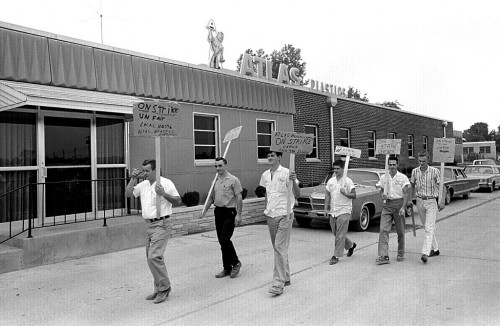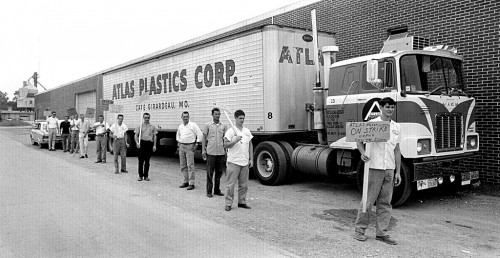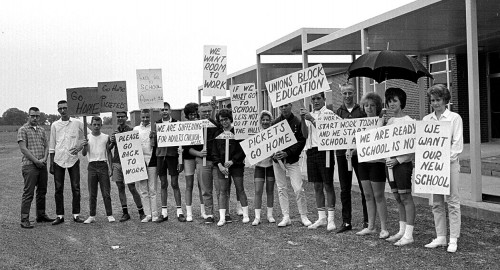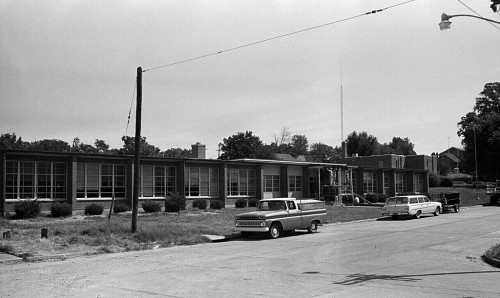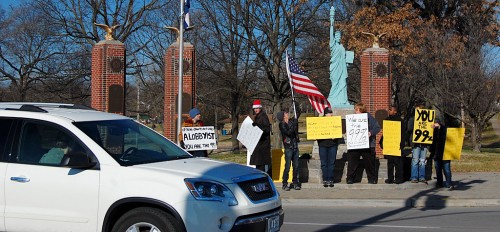 The Missourian ran a story about Occupy Cape in the November 6th paper, so I was hoping to run into them. The comments after the story were one of the reasons I’m sometimes ashamed to say I’m from here. Speak Out and the comments that follow stories contain mean-spirited, Yahoo-level talking parts that pass for wit in this area.
The Missourian ran a story about Occupy Cape in the November 6th paper, so I was hoping to run into them. The comments after the story were one of the reasons I’m sometimes ashamed to say I’m from here. Speak Out and the comments that follow stories contain mean-spirited, Yahoo-level talking parts that pass for wit in this area.
In case readers missed it the first time, one of them felt compelled to ask the question, “How about occupying a job?” twice.
Another wrote, “I observed them marching on William, in the hood, not sure what they are protesting Bet you that most of them play dungeons and draggons in their mothers basements.” [Spelling and punctuation as printed in the paper.]
I would encourage you to read the story, then the comments. Some of the demonstrators in this photo posted long, intelligent responses to the jabs and jibes. Click on any photo, by the way, to make it larger.
“Get A Job!”
 I spent about an hour on the corner with the group, numbering at most eight, including me. I was surprised at the number of friendly toots and waves they got. Only four people hollered, “Get A Job!”
I spent about an hour on the corner with the group, numbering at most eight, including me. I was surprised at the number of friendly toots and waves they got. Only four people hollered, “Get A Job!”
Eric, who is from the St. Charles area, would respond, “I’m working THREE jobs and going to grad school.”
61-year-old civil engineer
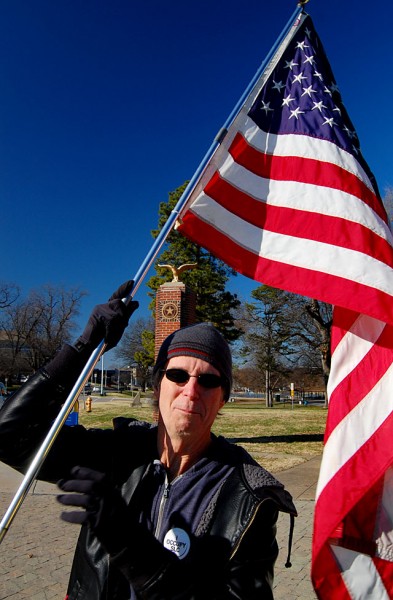 The Old Man of the movement on Saturday was Walden Morris, 61, a civil engineer and an LSU grad. He had been out in Salt Lake City for a year and a half working on a gas and oil pipeline project when he decided to attend a rally just to see what it was all about. Before he knew it, he was on the State Capitol steps speaking to 400 people under the watchful eyes of TV cameras. “I had been waiting for that moment for years. I just let ’em have it.”
The Old Man of the movement on Saturday was Walden Morris, 61, a civil engineer and an LSU grad. He had been out in Salt Lake City for a year and a half working on a gas and oil pipeline project when he decided to attend a rally just to see what it was all about. Before he knew it, he was on the State Capitol steps speaking to 400 people under the watchful eyes of TV cameras. “I had been waiting for that moment for years. I just let ’em have it.”
“Fed up with the way the country is being run”
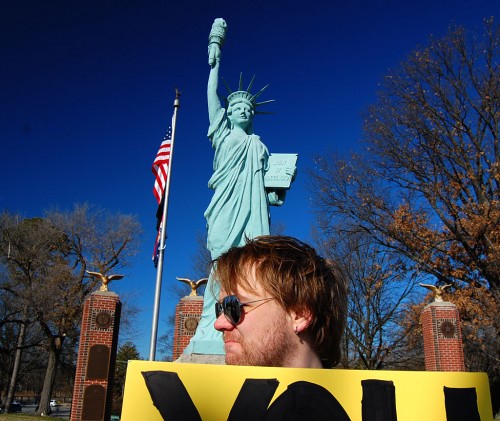 Chris McEwen, an art major from Mobile, Alabama, said he “got stranded in Cape for youthful reasons.”
Chris McEwen, an art major from Mobile, Alabama, said he “got stranded in Cape for youthful reasons.”
“What was her name?” I asked. He grinned and said, “You got that right.”
He was on the street corner because he’s “fed up with the way the country is bring run.” He’d like to see money taken out of politics.
Came from conservative Democrats
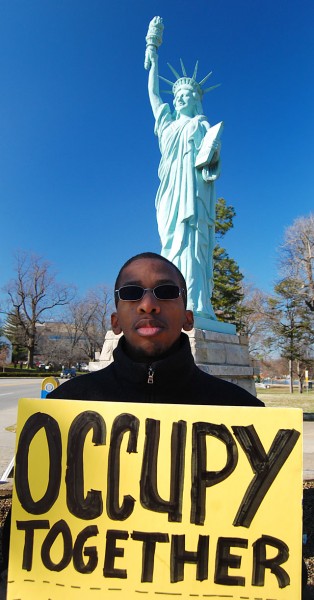 Nathaniel Lee, of St. Louis, came from a family of conservative Democrats. He has a dual major in accounting and international business. He’d like to get his C.P.A. and work as a federal auditor “trying to fix the system from within.”
Nathaniel Lee, of St. Louis, came from a family of conservative Democrats. He has a dual major in accounting and international business. He’d like to get his C.P.A. and work as a federal auditor “trying to fix the system from within.”
This IS Cape, after all
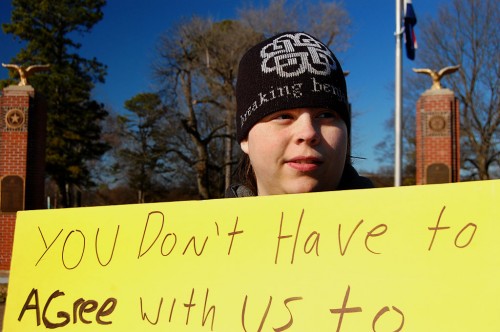 The group has a website, Occupy Cape Girardeau.
The group has a website, Occupy Cape Girardeau.
I had to be amused at a note in the Nov. 12, 2011, General Assembly Minutes: “We opened by appointing by consensus Kerrick Long as this week’s facilitator, after which he read the Principles of Solidarity using the People’s Mic. The principles of solidarity were interrupted when an officer of the Cape Girardeau Police Department arrived and stated that the CGPD received a complaint about the demonstration at Freedom Corner earlier. He said if we did not keep quiet demonstrating by the road, we could go to jail. We apologized, and said we would be sure not to shout too close to the road. He told us we could continue using the People’s Mic at the benches since it was farther from the road.”
Being a bit of a rebel, I’d have asked the cop to bring out a decibel meter to tell me how much more we were disturbing the peace in the middle of the afternoon in a public park compared to other activities in the park. These folks have a lot to learn about civil disobedience and standing up for your rights.
[The Occupy movement doesn’t use mechanical megaphones. They use “The People’s Mic,” where someone who wants to say something speaks in short bursts that are re-shouted by the group. Considering that the largest assembly in Cape has been less than 20, I doubt that hearing the speaker is a problem.]
1967 Protest at Petit N’ Orleans restaurant
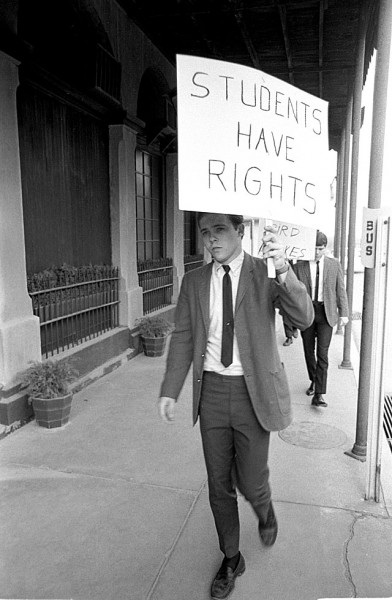 This was the last protest I covered in Cape. These SEMO students were protesting the Petit N’ Orleans restaurant’s dress code in 1967. The cops shut them down, too.
This was the last protest I covered in Cape. These SEMO students were protesting the Petit N’ Orleans restaurant’s dress code in 1967. The cops shut them down, too.
Education costs are rising
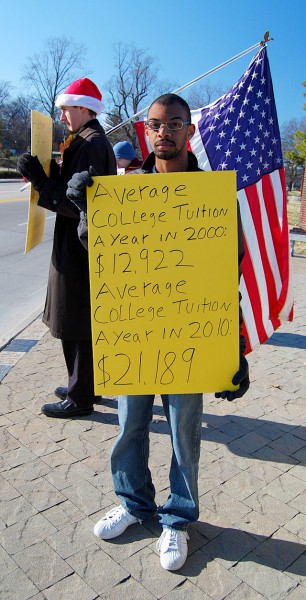 Brandon Burton, a pre-veterinary medicine major from St. Louis, is concerned about the rising cost of a college education.
Brandon Burton, a pre-veterinary medicine major from St. Louis, is concerned about the rising cost of a college education.
Parts of the Occupy Cape website makes me think I’m back in my treehouse days when I see a whole section in the General Assembly Guide devoted to “Hand Gestures.” The movement strikes me as unfocused and a bit naive at times: long on feel-good rhetoric and short on practical solutions.
I will say, though, if you are tempted to roll down your window and shout “Get a Job!” pull over to the side and talk with these folks. You may find that you have more in common with them than you think. A couple of the members concluded that they and the Tea Party are both saying the same thing: the system ain’t working. They may disagree about what’s broken, how it got broken and how to fix it, but they’re starting from a common viewpoint.
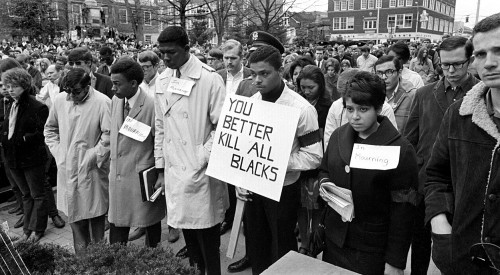 In the spring of 1968, I was photo editor of The Ohio University Post and a photography major. One of my classes – it might have been Magazine and Newspaper Photography – had us form up into teams. We had to pick a geographical area, then document what happened in that area for a week. Classmate Lyntha Scott Eiler was on The Athena, the university yearbook. The publications worked out of the student union building on the Main Green and, since we practically lived there anyway, we picked that as our geographical area. We recruited two more team members and set to work.
In the spring of 1968, I was photo editor of The Ohio University Post and a photography major. One of my classes – it might have been Magazine and Newspaper Photography – had us form up into teams. We had to pick a geographical area, then document what happened in that area for a week. Classmate Lyntha Scott Eiler was on The Athena, the university yearbook. The publications worked out of the student union building on the Main Green and, since we practically lived there anyway, we picked that as our geographical area. We recruited two more team members and set to work.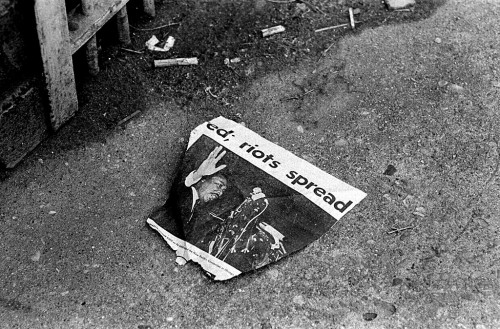 The mood of the campus changed in a heartbeat with a gunshot in Memphis, Tenn. Dr. Martin Luther King was dead.
The mood of the campus changed in a heartbeat with a gunshot in Memphis, Tenn. Dr. Martin Luther King was dead.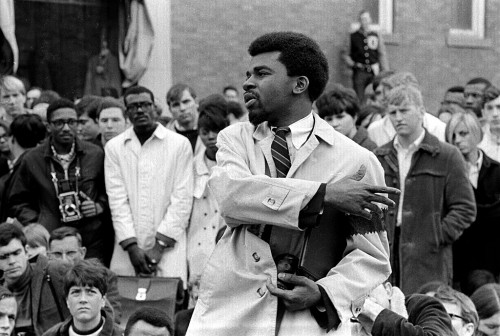 My team was lucky enough that our area was where a National Day of Mourning service was going to be held. When it broke up, the crowd moved a block north to the major intersection in town at Court and Union Streets to conduct a sit-in. This wasn’t unusual. That was the traditional spot for the annual Rites of Spring riot and anti-war protests. Cops and students would do a choreographed chicken dance, then everybody would break up and go home. Few arrests were made and teargas wasn’t used until after Kent State.
My team was lucky enough that our area was where a National Day of Mourning service was going to be held. When it broke up, the crowd moved a block north to the major intersection in town at Court and Union Streets to conduct a sit-in. This wasn’t unusual. That was the traditional spot for the annual Rites of Spring riot and anti-war protests. Cops and students would do a choreographed chicken dance, then everybody would break up and go home. Few arrests were made and teargas wasn’t used until after Kent State.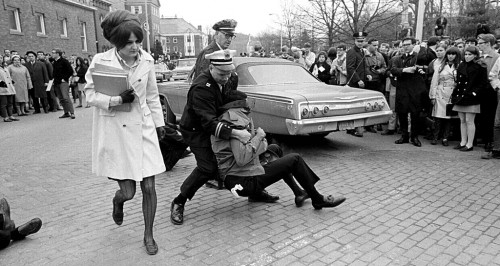 This time, though, a redneck Athens police captain decided he was going to literally throw the demonstrators off of his streets. He didn’t realize how raw emotions were. It was as close to sparking a race riot as Athens has ever come. Fortunately, cooler heads prevailed and the students were allowed to block the street for a “reasonable” amount of time.
This time, though, a redneck Athens police captain decided he was going to literally throw the demonstrators off of his streets. He didn’t realize how raw emotions were. It was as close to sparking a race riot as Athens has ever come. Fortunately, cooler heads prevailed and the students were allowed to block the street for a “reasonable” amount of time.
